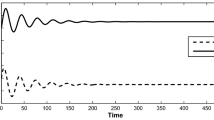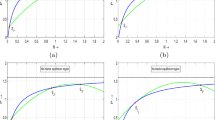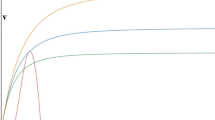Abstract
This work examines a discrete Leslie-Gower model of prey-predator dynamics with Holling type-IV functional response and harvesting effects. The study includes the existence and local stability analysis of all fixed points. Using center manifold theory, the codimension-1 bifurcations, viz. transcritical, Neimark–Sacker, fold, and period-doubling bifurcations, are determined for varying parameters. Moreover, the existence of codimension-2 Bogdanov–Takens bifurcation and Chenciner bifurcation is demonstrated, requiring two parameters to vary for the bifurcation to occur, and the non-degeneracy conditions for Bogdanov–Takens bifurcation are determined. An extensive numerical study is conducted to confirm the analytical findings. A wide range of dense, chaotic windows can be seen in the system, including period-2, 4, 8, and 16, period-doubling bifurcations, Neimark–Sacker bifurcations, and Chenciner and BT curves following two-parameters bifurcations. Further, it is also shown that the effect of harvesting parameter of the model for which the population dies out.









Similar content being viewed by others
Availability of Data
Data sharing does not apply to this article as no data sets were generated or analyzed during the current study.
References
Costantino, R., Cushing, J., Dennis, B., Desharnais, R.A.: Experimentally induced transitions in the dynamic behaviour of insect populations. Nature 375(6528), 227–230 (1995)
Cushing, J.M., Costantino, R.F., Dennis, B., Desharnais, R., Henson, S.M.: Chaos in ecology: experimental nonlinear dynamics, vol. 1 (Elsevier, 2003)
Desharnais, R.A., Costantino, R., Cushing, J., Henson, S.M., Dennis, B.: Chaos and population control of insect outbreaks. Ecol. Lett. 4(3), 229–235 (2001)
Turchin, P.: A theoretical/empirical synthesis, mongraphs in population biology, complex population dynamics, MPB- Vol. 35 (2003)
Bazykin, A.D.: Nonlinear Dynamics of Interacting Populations (World Scientific, 1998)
Hastings, A., Powell, T.: Chaos in a three-species food chain. Ecology 72(3), 896–903 (1991)
Singh, A., Gakkhar, S.: Controlling chaos in a food chain model. Math. Comput. Simul. 115, 24–36 (2015)
Sabin, G.C., Summers, D.: Chaos in a periodically forced predator-prey ecosystem model. Math. Biosci. 113(1), 91–113 (1993)
Berezovskaya, F., Karev, G., Arditi, R.: Parametric analysis of the ratio-dependent predator-prey model. J. Math. Biol. 43(3), 221–246 (2001)
Sen, M., Banerjee, M., Morozov, A.: Bifurcation analysis of a ratio-dependent prey-predator model with the allee effect. Ecol. Complex. 11, 12–27 (2012)
Wang, J., Shi, J., Wei, J.: Predator-prey system with strong allee effect in prey. J. Math. Biol. 62(3), 291–331 (2011)
Morozov, A.Y., Banerjee, M., Petrovskii, S.V.: Long-term transients and complex dynamics of a stage-structured population with time delay and the allee effect. J. Theor. Biol. 396, 116–124 (2016)
May, R.M.: The Theory of Chaotic Attractors (Springer), pp. 85–93 (2004)
Georgescu, P., Hsieh, Y.H.: Global dynamics of a predator-prey model with stage structure for the predator. SIAM J. Appl. Math. 67(5), 1379–1395 (2007)
Takeuchi, Y.: Global Dynamical Properties of Lotka–Volterra Systems (World Scientific) (1996)
Chakraborty, K., Jana, S., Kar, T.K.: Global dynamics and bifurcation in a stage structured prey-predator fishery model with harvesting. Appl. Math. Comput. 218(18), 9271–9290 (2012)
May, R.M., Oster, G.F.: Bifurcations and dynamic complexity in simple ecological models. Am. Natural. 110(974), 573–599 (1976)
Liz, E.: Local stability implies global stability in some one-dimensional discrete single-species models. Discrete Continuous Dyn. Syst. B 7(1), 191 (2007)
Huang, J., Liu, S., Ruan, S., Xiao, D.: Bifurcations in a discrete predator-prey model with nonmonotonic functional response. J. Math. Anal. Appl. 464(1), 201–230 (2018)
Din, Q.: Complexity and chaos control in a discrete-time prey-predator model. Commun. Nonlinear Sci. Numer. Simul. 49, 113–134 (2017)
He, Z., Lai, X.: Bifurcation and chaotic behavior of a discrete-time predator-prey system. Nonlinear Anal. Real World Appl. 12(1), 403–417 (2011)
Agiza, H., Elabbasy, E., El-Metwally, H., Elsadany, A.: Chaotic dynamics of a discrete prey-predator model with Holling type II. Nonlinear Anal. Real World Appl. 10(1), 116–129 (2009)
Singh, A., Sharma, V.S.: Bifurcations and chaos control in a discrete-time prey–predator model with Holling type-II functional response and prey refuge. J. Comput. Appl. Math. 418, 114666 (2023)
Sharma, V.S., Singh, A., Elsonbaty, A., Elsadany, A.: Codimension-one and-two bifurcation analysis of a discrete-time prey-predator model. Int. J. Dyn. Control, pp. 1–15 (2023)
Smith, J.M.: Mathematical Ideas in Biology (CUP Archive, 1968)
Levine, S.H.: Discrete time modeling of ecosystems with applications in environmental enrichment. Math. Biosci. 24(3–4), 307–317 (1975)
Liu, X., Xiao, D.: Bifurcations in a discrete-time Lotka-Volterra predator-prey system. Discrete Continuous Dyn. Syst. B 6(3), 559 (2006)
Hadeler, K., Gerstmann, I.: The discrete rosenzweig model. Math. Biosci. 98(1), 49–72 (1990)
Li, S., Zhang, W.: Bifurcations of a discrete prey-predator model with Holling type-II functional response. Discrete Continuous Dyn. Syst. B 14(1), 159 (2010)
Singh, A., Deolia, P.: Dynamical analysis and chaos control in discrete-time prey-predator model. Commun. Nonlinear Sci. Numer. Simul. 90, 105313 (2020)
Singh, A., Deolia, P.: Bifurcation and chaos in a discrete predator-prey model with Holling type-III functional response and harvesting effect. J. Biol. Syst. 29(2), 451–478 (2021)
Huang, J., Gong, Y., Ruan, S.: Bifurcation analysis in a predator-prey model with constant-yield predator harvesting. Discrete Continuous Dyn. Syst. B 18(8), 2101 (2013)
Xiao, D., Li, W., Han, M.: Dynamics in a ratio-dependent predator-prey model with predator harvesting. J. Math. Anal. Appl. 324(1), 14–29 (2006)
Din, Q.: Dynamics of a discrete Lotka-Volterra model. Adv. Differ. Eqn. 2013(1), 1–13 (2013)
Kuznetsov, Y.A.: Elements of applied bifurcation theory. Appl. Math. Sci. 112, 591 (1998)
Bogdanov, R.I.: Versal deformations of a singular point of a vector field on the plane in the case of zero eigenvalues. Funct. Anal. Appl. 9(2), 144–145 (1975)
Bogdanov, R.: Bifurcation of the limit cycle of a family of plane vector fields/versal deformations of a singularity of a vector field on the plane in the case of zero eigenvalues. Sel. Math. Sov. 1, 373–387 (1984)
Takens, F.: Singularities of vector fields. Publications Mathématiques de l’IHÉS 43, 47–100 (1974)
Takens, F., et al.: Forced oscillations and bifurcations. Appl. Glob. Anal. I Commun. 3, 1–62 (2001)
Chow, S.N., Li, C., Wang, D.: Normal Forms and Bifurcation of Planar Vector Fields (Cambridge University Press, Cambridge, 1994)
Dumortier, F., Roussarie, R., Sotomayor, J., Żaładek, H.: in Bifurcations of Planar Vector Fields (Springer), pp. 165–224 (1991)
Xiao, D., Ruan, S.: Bogdanov-Takens bifurcations in predator-prey systems with constant rate harvesting. Fields Inst. Commun. 21, 493–506 (1999)
Xiao, D., Ruan, S.: Global analysis in a predator-prey system with nonmonotonic functional response. SIAM J. Appl. Math. 61(4), 1445–1472 (2001)
Singh, A., Malik, P.: Bifurcations in a modified leslie-gower predator-prey discrete model with michaelis-menten prey harvesting. J. Appl. Math. Comput. 67, 1–32 (2021)
Singh, A., Sharma, V.S.: Codimension-2 bifurcation in a discrete predator-prey system with constant yield predator harvesting. Int. J. Biomath. 16(05), 1–27 (2022)
Alidousti, J., Eskandari, Z., Fardi, M., Asadipour, M.: Codimension two bifurcations of discrete bonhoeffer-van der pol oscillator model. Soft Comput. 25(7), 5261–5276 (2021)
Hsu, S.B., Huang, T.W.: Global stability for a class of predator-prey systems. SIAM J. Appl. Math. 55(3), 763–783 (1995)
Arditi, R., Ginzburg, L.R.: Coupling in predator-prey dynamics: ratio-dependence. J. Theor. Biol. 139(3), 311–326 (1989)
Liang, Z., Pan, H.: Qualitative analysis of a ratio-dependent Holling-Tanner model. J. Math. Anal. Appl. 334(2), 954–964 (2007)
Zhou, J.: Bifurcation analysis of a diffusive predator-prey model with ratio-dependent Holling type-III functional response. Nonlinear Dyn. 81(3), 1535–1552 (2015)
Amirabad, H.Q., RabieiMotlagh, O., MohammadiNejad, H.M.: Permanency in predator-prey models of Leslie type with ratio-dependent simplified Holling type-IV functional response. Math. Comput. Simul. 157, 63–76 (2019)
Yao, Y.: Bifurcations of a Leslie-Gower prey-predator system with ratio-dependent Holling-IV functional response and prey harvesting. Math. Methods Appl. Sci. 43(5), 2137–2170 (2020)
Broer, H.W., Roussarie, R., Simó, C.: Proceedings Equadiff 91 (World Scientific), pp. 81–92 (1993)
Broer, H., Roussarie, R., Simó, C.: Invariant circles in the Bogdanov-Takens bifurcation for diffeomorphisms. Ergodic Theory Dyn. Syst. 16(6), 1147–1172 (1996)
Kuznetsov, Y.A.: Elements of applied bifurcation theory, vol. 112 (Springer Science & Business Media) (2013)
Govaerts, W., Ghaziani, R.K., Kuznetsov, Y.A., Meijer, H.G.: Numerical methods for two-parameter local bifurcation analysis of maps. SIAM J. Sci. Comput. 29(6), 2644–2667 (2007)
Meijer, H., Govaerts, W., Kuznetsov, Y.A., Ghaziani, R.K., Neirynck, N.: Matcontm, A Toolbox for Continuation and Bifurcation of Cycles of Maps: Command Line Use. Utrecht University, Department of Mathematics (2017)
Funding
Anuraj Singh’s endeavors receive support from a Core Research Grant provided by the Science Engineering Research Board, an entity of the Indian government (CRG/2021/006380). The contribution of Vijay Shankar Sharma is funded by the University Grant Commission (UGC), also under the Indian government.
Author information
Authors and Affiliations
Contributions
VSS: Conceptualization, Methodology, Software, Validation, Formal analysis, Investigation, Data curation, Writing-original draft preparation. AS: Conceptualization, Methodology, Formal analysis, Resources, Supervision, Visualization, Investigation, Project administration. PM: Software, Validation, Formal analysis.
Corresponding author
Ethics declarations
Conflict of interest
No conflict of interest exists among the authors.
Consent to Participate
We hereby consent to participate.
Consent to Publish
We hereby consent to publish our paper.
Additional information
Publisher's Note
Springer Nature remains neutral with regard to jurisdictional claims in published maps and institutional affiliations.
Rights and permissions
Springer Nature or its licensor (e.g. a society or other partner) holds exclusive rights to this article under a publishing agreement with the author(s) or other rightsholder(s); author self-archiving of the accepted manuscript version of this article is solely governed by the terms of such publishing agreement and applicable law.
About this article
Cite this article
Sharma, V.S., Singh, A. & Malik, P. Bifurcation Patterns in a Discrete Predator–Prey Model Incorporating Ratio-Dependent Functional Response and Prey Harvesting. Qual. Theory Dyn. Syst. 23, 74 (2024). https://doi.org/10.1007/s12346-023-00929-2
Received:
Accepted:
Published:
DOI: https://doi.org/10.1007/s12346-023-00929-2




